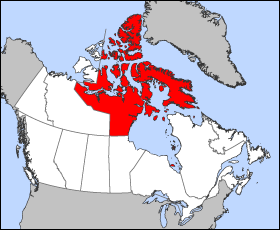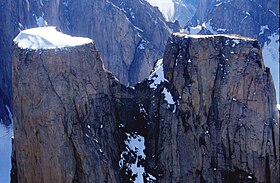 |
| Nunavut is shown in red. |
In essence the Arctic Cordillera are reworked rocks of the Canadian Shield and in many respects are similar to the Appalachians although the orogeny that formed them is much younger. The area is fairly heavily intruded with volcanics that are associated with the orogeny. To the west of these mountains Nunavut Canadian Shield . There are a series of greenstone belts that are found throughout the Canadian Shield including those found in Nunavut Canada
 |
| The Meadowbank Gold Mine under construction. Photo by Agrico-Eagle Mining |
At one time in 1999 there were two operational mines in Nunavut
There is an active exploration industry and several other mines are in the process of being opened. Prospecting in Nunavut
 |
| Mt Aasgard in Nunavut is one example of the terrain you will encounter. It is located on Baffin Island |
Unlike other parts of Canada Nunavut